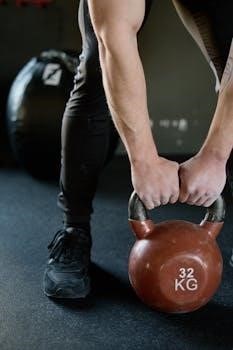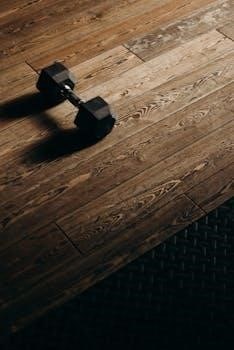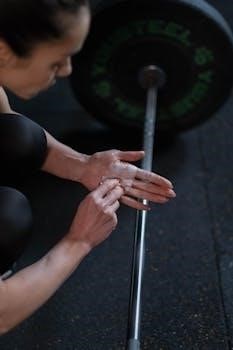
Strength training is crucial for volleyball players, enhancing agility, power, and overall court effectiveness. A tailored program focusing on functional movements is key. It’s not about building large muscles, but rather improving performance.
Importance of Strength Training for Volleyball
Strength training is paramount for volleyball players, directly impacting their ability to perform explosive movements like spiking, blocking, and diving. It’s not about bulk, but about generating power and agility on the court. A well-structured program enhances jumping ability, crucial for both attacking and defensive plays. Moreover, strength training bolsters stability and reduces injury risks, allowing players to perform more consistently. This training must be specific, focusing on muscle groups used in volleyball such as quads, hamstrings, glutes, lats, chest, and core. It’s essential for improving overall performance and maintaining a healthy body throughout a season. Strength training leads to faster adaptation and improved sports performance. Incorporating the right exercises ensures players maintain energy and stamina, improving their cardiovascular endurance. Remember, the aim is functional strength that supports volleyball-specific movements.

Key Components of a Volleyball Strength Program
A successful volleyball strength program focuses on lower body, upper body, and core strength. These components help generate power and explosiveness for court movements and overall game performance.
Focus on Lower Body Strength
Lower body strength is paramount for volleyball players, as it forms the foundation for jumping, quick lateral movements, and powerful spikes. Exercises such as squats, lunges, and deadlifts are essential for developing the necessary power in the quads, hamstrings, and glutes. These exercises not only enhance explosive movements but also improve stability and balance on the court. Incorporating these into a routine will enable athletes to generate more force when jumping and moving laterally during gameplay. By focusing on lower body strength, volleyball players can improve their vertical jump, speed and agility which are very important for success in this sport. Additionally, building strength in this area can help reduce the risk of injuries during intense practices and games. A strong lower body is a must have for any volleyball player.
Upper Body Strength Training Exercises
Upper body strength is vital for volleyball players, contributing to powerful spikes, blocks, and setting actions. Exercises that target the chest, back, shoulders, and arms are essential components of a well-rounded training program. Bench presses, rows, and overhead presses help build the necessary muscle strength and power. The lats and chest muscles play important role in spiking and blocking, so these muscles must be included in training. Proper upper body strength enhances ball control and precision. It’s not about building bulky muscles but rather functional strength that translates to better performance on the court. This training helps in achieving more powerful and controlled actions. Therefore, a well structured upper body strength program is crucial for any volleyball player looking to improve their game. It is very important to have a balance between all body groups.
Core Strength Development
Core strength is paramount for volleyball players, providing stability and power for all movements on the court. A strong core enhances balance, agility, and the ability to generate power in spikes and serves. Exercises like planks, Russian twists, and medicine ball throws are crucial for developing this foundational strength. A stable core allows for more efficient transfer of power from the lower body to the upper body, improving overall performance. It’s not just about abdominal muscles; it’s about the entire midsection. Strong core improves balance and helps in quick directional changes. Core training is essential to prevent injuries and promote effective athletic movements. Therefore, incorporating core exercises in the training program helps in effective performance on court. Core exercises help the player to maintain balance and be more agile in quick movement situations.
Designing an Effective Training Program
Effective volleyball training requires understanding game movements and progressive overload. It’s not just about exercises; it’s about creating a system that builds strength sustainably. A well-crafted program aligns with the sport.
Understanding Movement Patterns in Volleyball
Creating an effective volleyball strength training program necessitates a deep understanding of the sport’s dynamic movement patterns. Volleyball demands explosive actions such as jumping for blocks and spikes, quick lateral movements for defense, and powerful core engagement for serving and digging. The program should mirror these needs. It’s crucial to analyze the specific actions performed during a match, focusing on the muscles utilized and the planes of motion involved. This understanding allows for exercises that directly translate to improved on-court performance. By addressing the specific demands of volleyball, athletes can develop functional strength and agility, leading to better performance and a reduced risk of injuries. It’s not just about lifting weights, it’s about training the body for the game.
Progressive Overload Principle
The principle of progressive overload is fundamental to any effective volleyball strength training program. To continually improve, athletes must gradually increase the demands placed on their bodies. This can be achieved by increasing the weight lifted, the number of repetitions, or the sets performed. Another method is to reduce rest intervals between sets or increase the difficulty of the exercises themselves. For example, a player may start with bodyweight squats and then progress to barbell squats, adding weight over time. This consistent increase in demand is vital for stimulating muscle growth, strength gains, and overall performance enhancement. Without progressive overload, the body will adapt to the current training load, and further progress will stagnate. Therefore, it is essential to track progress and make adjustments to the training program as needed to ensure continued adaptation and improvement.

Specific Exercises for Volleyball
Volleyball-specific exercises include squats and deadlifts for power, plyometrics for explosiveness, and agility drills for lateral movement. These focus on enhancing the actions needed on the court.
Squats and Deadlifts for Power
Squats and deadlifts are fundamental exercises for volleyball players, crucial for developing lower body strength and power. These movements engage multiple muscle groups, including the quads, hamstrings, and glutes, which are essential for jumping, blocking, and explosive movements on the court. Specifically, front squats are preferred due to their functional strength benefits, closely mimicking the body’s position during volleyball actions. Incorporating both back and front squats can provide a well-rounded approach to lower body training. Deadlifts, on the other hand, contribute to overall power development, strengthening the posterior chain and improving the ability to generate force during spikes and dives. Proper form and technique are paramount to maximizing the benefits of these exercises while minimizing injury risks. These exercises should be integrated into a structured training program to progressively build strength and power.
Plyometrics for Explosiveness
Plyometric exercises are indispensable for volleyball players aiming to enhance their explosiveness and jumping ability. These drills focus on rapid, powerful movements that mimic the actions required on the court, such as jumping, spiking, and blocking. Exercises like box jumps, jump squats, and lateral bounds are crucial for developing the fast-twitch muscle fibers necessary for quick, powerful bursts of energy. Plyometrics improve the stretch-shortening cycle, enabling athletes to generate more force in less time. It’s essential to start with proper technique and gradually increase the intensity and complexity of the drills to avoid injuries. Integrating plyometrics into a well-structured training program, alongside strength training, will lead to significant improvements in vertical jump height and overall court performance. Remember, proper warm-up and cool-down routines are vital for optimizing results and reducing injury risks.
Agility and Lateral Movement Drills
Agility and lateral movement are fundamental for volleyball players, requiring quick changes in direction and rapid footwork. Incorporating specific drills targeting these skills is crucial for enhancing on-court performance. Lateral shuffles, cone drills, and carioca steps are excellent exercises for improving agility and the ability to move effectively in all directions. These drills not only enhance speed but also improve the player’s balance and coordination, essential for reacting to the ball and opponents. Practicing these movements regularly helps develop the necessary muscle memory for seamless transitions on the court. A well-structured program must include a variety of agility drills to ensure a comprehensive approach to enhancing lateral quickness and overall court mobility. These exercises should be performed with attention to proper form to maximize their effectiveness and prevent injuries.

Training Phases and Periodization
Volleyball training should be organized into phases, adapting to in-season and off-season needs. Periodization is essential for structuring training and optimizing performance improvements through cycles and planned periods.
In-Season vs Off-Season Training
Volleyball strength training programs must differentiate between in-season and off-season demands. In-season, the focus shifts to maintaining strength and power while prioritizing recovery. Training volume decreases, and intensity is adjusted to complement game schedules. Off-season training emphasizes building foundational strength, addressing weaknesses, and increasing overall power output. This phase allows for higher training volume and intensity, focusing on developing a robust athletic base. It’s crucial to cycle training to avoid overtraining and ensure peak performance during the competitive season. The program should adapt to the athlete’s current phase, optimizing performance and minimizing injury risk. By considering these variations, athletes can achieve consistent progress and better results on the court.
Anatomical Adaptation Phase
The Anatomical Adaptation (AA) phase is the initial stage of a volleyball strength training program, crucial for preparing the body for more intense workouts. It focuses on building a solid foundation by strengthening connective tissues, muscles, and joints. This phase incorporates lighter weights, higher repetitions, and emphasizes proper form. The goal is to enhance overall muscular endurance and stability. Exercises during this period may include bodyweight movements and light resistance training. The AA phase is essential for preventing injuries and creating a strong base for future strength and power development. It also introduces athletes to proper lifting techniques and movement patterns, setting the stage for more advanced training methods. It is a foundational period for volleyball players.

Preventing Overtraining and Injury
Rest and recovery are vital to prevent overtraining and injury in volleyball. Proper rest ensures the body can adapt to training, thus improving performance. Avoid burnout.
Importance of Rest and Recovery
Rest and recovery are absolutely essential components of any effective volleyball strength training program. Ignoring these vital aspects can significantly increase the risk of overtraining, leading to decreased performance and potential injuries. Adequate rest allows the body to repair and rebuild muscle tissue damaged during intense workouts. Without sufficient recovery, athletes may experience fatigue, reduced strength gains, and a higher susceptibility to illness. It is crucial to integrate rest days into the training schedule and prioritize quality sleep. Additionally, active recovery methods, such as light stretching and foam rolling, can help reduce muscle soreness and improve overall recovery. By prioritizing rest and recovery, volleyball players can maximize the benefits of their training while minimizing the risk of injury and burnout, ensuring long-term progress and success on the court. Proper recovery is not just about taking time off, but it’s about strategically allowing the body to adapt and become stronger.